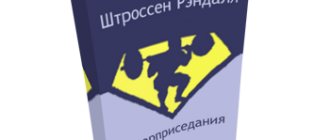Author: Timko Ilya - the ruler of the entire site and fitness trainer | more details >> Rod. 1984 Trained since 1999 Trained since 2007. Author and creator of the site tvoytrener.com. CCM in powerlifting. Champion of Russia and South Russia according to AWPC. Champion of the Krasnodar region according to IPF. 1st category in weightlifting. 2-time winner of the Krasnodar Territory championship in t/a. Author of more than 700 articles on fitness and amateur athletics. Author and co-author of 5 books.
Place in the author rating:
out of competition
(become an author)
Date:
2014-08-29
Views:
27,111
Rating:
5.0
| All articles by the author >> | Medals articles >> |
Articles are loading...
To begin with, I will say a few words about what this method is. Because not everyone is familiar with him. Mike Mentzer (pictured on the left) described this method in his book “Supertraining”. Its essence is that there is no need at all, or rather, it is not necessary to do several approaches to any muscle group.
Physiologists have long proven that when we do a set, only the last repetitions are decisive against the background of extreme fatigue of the working muscles. That is, if we can achieve this extreme fatigue in just one approach, then there is no need for other approaches. I studied human physiology at university for four years, and I would say that this is true. And from a physiological point of view, Mentzer’s method is ideal.
But that is not all. Mentzer decided not to stop there and moved on. Again, based on physiology. It has long been a known fact that the greater the load on the muscles, the more time the muscles need to recover and super-recover. And our body doesn’t care whether we did 5 approaches or just one. The main thing is the final effect. And the final effect here is the degree of muscle fatigue, which, according to Mentzer, can be achieved in one approach.
But I never said where Mentzer went after all)) Based on all of the above, he decided that each muscle can and should be trained once every 7 - 10 days. Why is that? There have been several experiments that have shown that the first negative changes in muscles begin to occur no earlier than 10 days after stopping training. That is, these are only the very first negative changes. AND NOT EARLIER than 10 days later. That's why Mike decided that 7 - 10 days was the optimal period. And the muscles will have time to rest, and degenerative changes will not yet have time to occur. But this, mind you, is provided that you have brought your muscles to maximum fatigue during training.
I think that now you understand the essence of the technique. We take some muscle group and do 2-3 exercises for it. But ONE approach per exercise until complete failure. Then we give these muscles a rest for 7–10 days. That is, during these 7–10 days we train other muscles, with which we do the same.
Preface about the author of the program
If you’ve been working out in the gym for more than a year, you’ve probably heard about the so-called “high-intensity training” (the abbreviation “HIT” is often used), or at least about its founder, Mike Mentzer.
Mike Mentzer was born on November 15, 1951 in Pennsylvania. Like many famous bodybuilders of his time, Mike was interested in “hardware” from childhood, and by the age of 20 he had already managed to practice well. In 1971, Mentzer competed at the Mr. America competition and immediately took 10th place. For a newbie, this could be considered a successful start.
Also in 1971, Mike met Arthur Jones and learned about the concept of “High Intensity Training”
and began to introduce this concept into my training, refining it along the way. Mentzer was actively building muscle mass and preparing for the assault on Olympus.
However, at the peak of his career, two unsuccessful (in Mentzer’s maximalist view) performances at the Mr. Olympia competition followed: in ’79, Mike won the heavyweight division, but lost in the overall competition to the lighter Zane, and in ’80, the plans were thwarted by the “returning "Schwarzenegger. As a result, Mentzer decided to leave competitive bodybuilding and devote himself entirely to coaching.
1980. Mentzer’s plans were confused by His Majesty Arnie, who triumphantly returned to “Mr Olympia”.
As a coach, Mentzer is known for his most successful student, Dorion Yatz, who became the winner of the Mr. Olympia competition six times, training according to the system proposed by Mike.
His achievements
Mike first took part in the Mr. Olympia competition in 1979, competing in the heavyweight division. Here he confidently wins, but takes second place in the absolute category, remaining behind Frank Zane. The next year he decides to participate in this prestigious tournament again, but he only managed to take 5th place. As for the winner, it turned out to be the well-known Arnold Schwarzenegger, who decided to return to bodybuilding. Then there were rumors that Arnold Schwarzenegger did not show anything unique at the competition, but for some reason he was the first. There were also rumors that everything was purchased in advance. In fact, the contrast was visible between the 1975 Arnold and the 1980 Arnold, as Mike Mentzer himself admitted.
Training strategy
Mike Mentzer and his high-intensity training, at one time (80s of the 20th century), made a real revolution in bodybuilding, going “contrary” to the then prevailing theory of “volume training”.
Mentzer rightly believed that muscles “respond to growth” only under stress. those. to one that forces the athlete to use his full muscle potential. Mentzer considered the principle of “refusal” and a small amount of training work to be one of the “helpers” in causing muscle stress. Those. one muscle group had to be worked out in 1-2 approaches, but this should be done until “failure”.
Failure
is the complete inability of the athlete to lift and/or lower the weight. Achieved through a high number of repetitions, possibly with a gradual decrease in working weight.
Another of Mentzer's training principles was a long recovery period after hard training. Rest between workouts could last up to 3-4, or even 5 days. The muscles, according to Mike, should fully recover after training of such intensity.
Mentzer paid special attention to the individuality of athletes. He believed that you shouldn’t take the “star program” and mindlessly train according to it. You should study your own body, its capabilities, weaknesses and strengths, and create your own training program.
The effectiveness of high-intensity training
Fine. I think you understand the essence of VIT. It is very simple: a small amount of strength work (few sets), but to hard failure, followed by many days of rest.
Does it work? Yes, it works. And the “Colorado experiment” is proof of this.
Can we say that low-volume HIT is the best training? No and again no, because there is much more successful evidence of high-volume training (starting with Arnold and ending with modern champions). Then why does Mentzer's HIT work?
There are many mistakes that athletes traditionally make, which are “cured” by training according to Mike Mentzer. Here are the TWO main ones:
- THE LOAD DOESN'T MATCH THE athlete's RECOVERY CAPABILITIES .
People do too much strength work, forgetting that the body needs to be prepared for such powerful stress gradually, otherwise there will be overtraining, which is what half of serious beginner bodybuilders find themselves in.
- NO LOAD PROGRESSION
People go to the gym for years doing the same amount of strength work with the same weights. Those. the load does not increase. This means that the muscles also have no need to grow.
If a person starts training “according to Mentzer,” then at a minimum he immediately adds more days of rest, thereby adjusting the load and his recovery capabilities (giving the muscles time to grow). In addition, by performing only one approach to failure, you are forced to constantly increase the weight on the bar so that the load is heavy enough to fail. This leads to progression in increased load and muscle growth, respectively.
This progress will be especially noticeable if a person has never trained with HIT before. The muscles thus receive a new load and are forced to adapt to it by increasing strength and size.
However, all athletes who try to train “according to Mentzer” very soon notice a stop in their gains. This usually happens after 1-2 months. Moreover, the gains that are observed occur mainly in large muscle groups (legs, back, chest) and almost never occur in small ones (shoulders, biceps, triceps). Why is that?
Because in 1-2 months the muscles and nervous system optimize their work to the maximum (this manifests itself in an increase in weight on the barbell), and after the “system is set up” the process slows down. Body function is optimized, and gains in muscle size require an increase in load, which is very small (one approach). If you force it further, injuries begin (ruptures of tendons, muscles, etc.).
Large muscles are not designed by nature to make one maximum effort per approach. If this were true, then the most muscular guys would be powerlifters. Large muscles are designed by nature to perform a lot of strength efforts over and over again over a period of time.
It's one thing if you do one set with a weight of 150 kg (8 repetitions will give 1200 kg), and a completely different thing if you do 10 approaches with a weight of 100 kg (8 repetitions will give 8000 kg). Simple math will tell you that in the second case you need to spend more than in the first. This means there should be more tools (muscles) for such expenses. Few people think about this. But the essence of bodybuilding is STRENGTH PERFORMANCE (do heavy strength work for a long time), and not STRENGTH POWER (do it once at most). This is fundamentally important. And we’ll talk about this in the next story, “Volume muscle training (the essence of bodybuilding) . ” Many revelations await you.
Basic training program “HIT” from Mike Mentzer
Workout 1
● Chest: bench fly + bench press (superset), 1x6-10 ● Back: pullover + vertical row (superset), 1x6-10 ● Back: deadlift, 1x6-10
3 days of rest, training on the 4th day
Workout 2
● Legs: leg extensions + leg press (superset), 1x6-10 ● Legs: standing calf raises, 1x6-10
3 days of rest, training on the 4th day.
Workout 3
● Deltas: side dumbbell swings, 1x6-10 ● Deltas: bent over dumbbell swings, 1x6-10 ● Arms: standing biceps curl, 1x6-10 ● Arms: pulley press + parallel bars, 1x6-10
3 days of rest, training on the 4th day
Workout 4
● Legs: leg extensions + squats, 1x6-10 ● Legs: standing calf raises, 1x6-10
3 days of rest, on the 4th day repeat the cycle
Biography
Mentzer was born and raised in an American city near Philadelphia. Since childhood, he was attracted to sports, especially bodybuilding. In 1971, Mr. America participated for the first time and took 10th place. After the competition, Casey Viator introduced Mentzer to Arthur Jones, the originator of the idea of High-Intensity Training. Mike liked this idea, and he used it with his brother Raymond.
At the Olympia 79 competition, Mentzer won in the heavyweight division, but in terms of overall performance he lost to Frank Zane, a lighter athlete. At the Olympia-80 competition, he hoped to win. But Schwarzenegger appeared and Mentzer took only 5th place. Afterwards, Mike Mentzer left and quit bodybuilding and became a coach. He trained Dorian Yates, who won the Olympia more than five times.
Mike Mentzer has developed a training system that includes plenty of rest. At the same time, the time and number of approaches are reduced. Mentzer wrote a book that talks in detail about bodybuilders, a special training plan and the principles of super training. He died on June 10, 2001, at the age of forty-nine.
Comments on the program
- In all exercises of the complex, only one single approach (warm-up ones do not count) until complete muscle failure , in 6-10 repetitions.
- In most exercises, as you have already noticed, the number of repetitions varies from 6 to 10. But this is not a dogma. If you pay attention to the incline bench press or dips, you will see that the number of repetitions is different.
- The technique of performing exercises should not “suffer”. All exercises are performed clearly, slowly, with stops at the extreme “points” of the movement.
- Select working weights in such a way that you can do the planned number of repetitions. No more and no less. But always remember about “refusal” . Each approach should end with it.
- Always warm up . General warm-up before training and special warm-up before exercise. This will increase blood flow to the muscles and minimize the likelihood of injury.
- The selection of exercises in the program is not accidental, but you can and should “deviate” from it, adjusting the program to suit you. When choosing new exercises for your program, always remember the “pre-exhaustion” rule for supersets - there should always be an isolation exercise before a heavy basic exercise.
- Keep a close eye on the weights on the bar and increase them as you progress.
- During a high-intensity training program, eat well and get plenty of sleep. Good rest and good food are the key to your success!
- After 1-3 months, after your progress on the scales has slowed, switch to a different type of training to avoid overtraining.
Read before training:
All basic exercises with correct technique
Training program for maximum effective muscle growth from scientists
How hard should you train?
5 reasons why you look like you don't exercise
5 reasons why your workout is ineffective
Squats in Bodybuilding and Powerlifting: 10 Important Differences
How to pump up the press correctly
How to squat with a barbell correctly
Training for a beginner. The beginning of time.
12 rules. How to avoid looking like a sucker at the gym
What is “overtraining” and why is it very dangerous?
Excerpt characterizing Mentzer, Mike
Danger is always not so scary when you know what it looks like... And so it is here - I told myself that I was just dealing with a drunken, embittered person, whom I would never be afraid of again. This time the door opened much faster. There was indescribable surprise on Arthur's drunken face. “Is it really you again?!..” he couldn’t believe it. I was very afraid that he would slam the door again, and then I would have no chance left... - Dad, daddy, don’t hurt her! She will leave and then no one will help us!!! – the girl whispered almost crying. - It's me, your little fox! Do you remember how you promised to take me to the magic mountain?!.. Remember? “She glared at me with her round pleading eyes, desperately asking me to repeat her words. I looked at her mother - Christina also nodded. This didn’t seem like a good idea to me, but I had no right to decide for them, because this was their life and this was, most likely, their last conversation... I repeated the little girl’s words, and was immediately horrified by the expression on her unfortunate father’s face - it seemed as if he had just been stabbed deep in the heart... I tried to talk to him, tried to somehow calm him down, but he was insane and did not hear anything. – Please come inside! – the little girl whispered. Somehow squeezing past him into the doorway, I entered... There was a suffocating smell of alcohol and something else in the apartment that I could not identify. Once upon a time, this apparently was a very pleasant and cozy apartment, one of those that we called happy. But now it was a real “nightmare”, from which its owner, apparently, was not able to get out on his own... Some broken porcelain pieces lay on the floor, mixed with torn photographs, clothes, and God knows what else. The windows were covered with curtains, making the apartment dark. Of course, such “being” could only truly inspire mortal melancholy, sometimes accompanied by suicide... Apparently Christina had similar thoughts, because she suddenly asked me for the first time: “Please, do something!” I immediately answered her: “Of course!” And I thought to myself: “If only I knew what!!!”... But I had to act, and I decided that I would try until I achieve something - or he will finally hear me, or (in the worst case) he will be thrown out the door again. - So are you going to talk or not? – I asked deliberately angrily. “I don’t have time for you, and I’m here only because this wonderful little man is with me - your daughter!” The man suddenly plopped down in a nearby chair and, clasping his head in his hands, began to sob... This went on for quite a long time, and it was clear that he, like most men, did not know how to cry at all. His tears were stingy and heavy, and they apparently were very, very difficult for him. It was only then that for the first time I truly understood what the expression “man’s tears” meant... I sat down on the edge of some bedside table and watched in confusion this stream of other people’s tears, having absolutely no idea what to do next?.. - Mom, mommy, Why are there such monsters walking around here? – a frightened voice asked quietly. And only then did I notice very strange creatures that were literally “in heaps” hovering around the drunken Arthur... My hair started to move - these were real “monsters” from children’s fairy tales, only here for some reason they even seemed very, very real... They were look like evil spirits released from a jug, who somehow managed to “attach” directly to the poor man’s chest, and, hanging on him in clusters, with great pleasure “devoured” his almost exhausted life force...
Beginning of a coaching career
After 1980, when Mike suffered a setback, he no longer participates in tournaments, but switches to coaching. His further success is due to the fact that he discovered a completely new training system, which led to the emergence of new approaches to the training system for bodybuilders. His theory was confirmed by Dorian Yates, who won the prestigious Mr. Olympia tournament 6 times, despite the fact that Mike began training with this athlete at the age of 20. By sports criteria, this is quite late, although not so early, considering the age at which Mike himself began training.
When his coaching career was just beginning, he used a slightly different training process scheme for his student Jones, but this did not give the desired result, and Mike decided to create his own methodology. After analyzing the entire process, he concludes that the problem is due to muscle overload, so he works on exercises that are more vigorous but take less time. The fact is that muscles grow during the process of rest, and muscles need to be fully restored. After several years of hard work, it turned out that students achieve optimal results when the number of approaches is reduced. He reduces their number to 2-4 approaches, over 4-7 days. This theory was seriously criticized, but Mentzer did not deviate from it and insisted on his own. After some time, he managed to prove that he was right. Mike himself considered himself a workaholic who was ready to work 12 hours a day in order to get great pleasure.
Mike Mentzer The Story of a Great Bodybuilder











